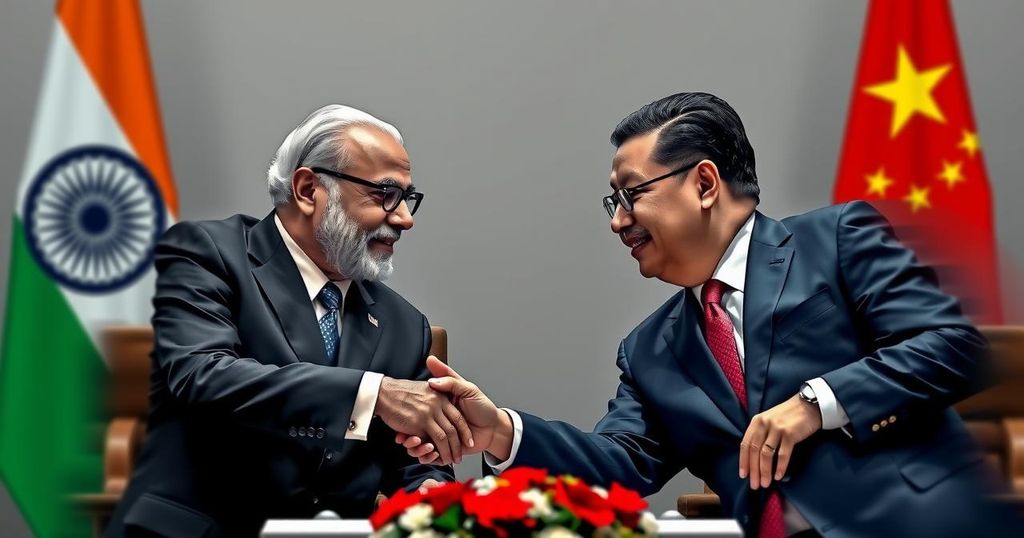Prospects for India-China Relations Post-BRICS Summit: A Potential Reset?

At the BRICS summit, Chinese President Xi Jinping and Indian Prime Minister Narendra Modi engaged in their first substantive dialogue in five years, aiming to de-escalate tensions following their 2020 border clash. An agreement for troop disengagement was announced, despite concerns over territorial disputes and the future of economic ties, with India re-evaluating its stance on Chinese investments. The engagement reflects a potential shift in India’s strategic posture amidst U.S.-China tensions.
During the recent BRICS summit in Kazan, Russia, two of the world’s most populous leaders, Chinese President Xi Jinping and Indian Prime Minister Narendra Modi, engaged in their first substantial bilateral discussion in five years. This meeting aimed to address the long-standing and contentious relationship between their nations, particularly following the violent border clash in Ladakh in 2020, which resulted in significant military casualties on both sides. The two leaders’ encounter came shortly after Indian Foreign Secretary Vikram Misri announced an agreement facilitating troop disengagement in areas where they had remained in prolonged standoffs since the aforementioned conflict. This agreement signifies a crucial step towards stabilizing ties between India and China and impacts geopolitical dynamics in Asia, particularly in relation to the United States. The dichotomy between the U.S. and China plays a vital role in India’s foreign policy strategies. While both India and the U.S. view China as a principal adversary, scholars suggest that India’s decision to thaw relations with Beijing may be a response to a concern of over-reliance on its partnership with Washington. Zorawar Daulat Singh, a noted analyst, remarked, “The India-China detente is the most significant geopolitical development in Asia this year. It means that India has decided to remove itself from U.S. cold war plans.” However, the specifics and implications of the disengagement deal remain unclear. Reports indicate that territorial control along their contested borders remains ambiguous, with some suggesting that China has encroached upon areas previously held by India. Former Indian military officials emphasized the absence of transparency surrounding the agreement’s parameters, raising concerns regarding the actual territorial status. Current Indian government narratives assert that no Indian land has been occupied by Chinese forces since 2020; yet, contradictions remain, given the ongoing military engagement discussions. The broader ramifications of the Modi-Xi meeting extend beyond military tensions, particularly concerning economic relations. India has imposed significant restrictions on Chinese investments following the border clash, banning a multitude of Chinese applications and scrutinizing inbound investments rigorously. However, a recent decline in foreign direct investment has prompted calls from Indian policymakers to revisit their stances on Chinese economic engagement. Former automobile executive Vipin Sondhi articulated that tapping into Chinese investments could bolster India’s economy and create jobs, advocating for a careful distinction between sectors needing heightened security and those that should welcome greater collaboration with Chinese partners. Amidst these developments, speculation regarding India’s motives for engaging China arises. Some analysts speculate that India may be signaling to the West amid increasing diplomatic pressures over alleged transgressions of sovereignty. Nonetheless, others interpret the meeting as a pragmatic step towards achieving a balanced relationship with China while acknowledging the inherent strategic concerns that continue to shape India’s geopolitical landscape.
The relationship between China and India has been fraught with tensions, particularly following the deadly border clashes in Ladakh during 2020. This incident resulted in a re-evaluation of strategic ties and mutual perceptions of threat between the two nations. The BRICS summit provided a platform for both leaders to engage in dialogue amidst broader geopolitical shifts, including India’s balancing act in relation to U.S.-China dynamics. The implications of their discussions, particularly concerning military disengagement and economic cooperation, are crucial for regional stability.
In conclusion, the recent engagement between President Xi Jinping and Prime Minister Narendra Modi marks a significant potential pivot in India-China relations, acknowledging the complex interplay of military and economic factors. While an agreement on troop disengagement has been reached, numerous uncertainties remain regarding territorial integrity and economic collaboration going forward. The evolving relationships speak volumes about the shifting alliances and strategies within the broader scope of Asian and global geopolitics.
Original Source: www.aljazeera.com







